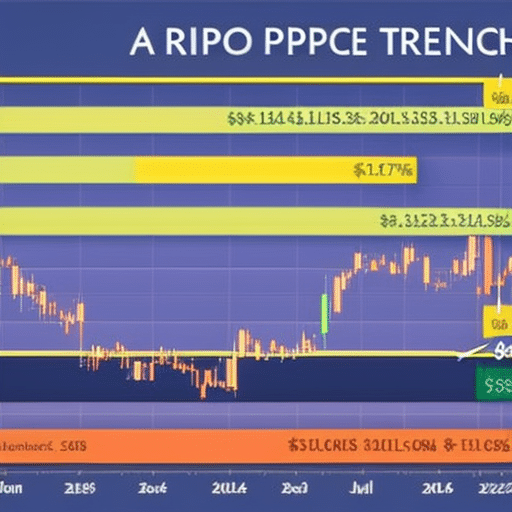Xrp’s Contribution To Economic Stability
Ripple’s XRP is a cryptocurrency that has been gaining attention for its potential to revolutionize international payments. It has the advantage of being faster, cheaper and more secure than traditional payment methods. This article will explore how XRP could contribute to economic stability by examining its role in international payments, banking, businesses, financial institutions and regulation. Furthermore, it will analyze the impact of XRP on economic growth and financial stability.
XRP uses blockchain technology to process transactions quickly and securely without relying on third-party intermediaries like banks or payment processors. It also offers low transaction fees compared to traditional methods, giving it an edge over other digital currencies such as Bitcoin or Ethereum. Moreover, its decentralized nature makes it attractive to those who want to avoid centralized control from governments or financial institutions. As such, XRP aims to provide users with greater control over their funds and enable them to make cross-border payments at lower costs while maintaining high levels of security.
Overview of XRP
XRP is a digital asset that serves as a bridge between two different currencies, allowing for faster and more efficient cross-border payments. It utilizes blockchain technology to secure transactions and offers various security features to ensure the safety of the funds being exchanged. XRP also provides interoperability benefits due to its open source platform, which makes it easy to move money between different financial systems. This allows for increased liquidity in global markets, providing an essential element for economic stability. Furthermore, XRP’s ability to facilitate quick and low-cost international payments helps reduce transaction costs associated with foreign exchange fees and delays in processing payments. These factors combined make XRP a valuable asset when it comes to economic stability around the world. Moving on, its contribution towards this goal can be further examined by looking at the benefits of utilizing XRP.
Benefits of XRP
Cryptocurrency technology provides potential benefits for financial transactions due to its ability to facilitate fast and secure transfers with low fees. XRP is one such digital asset that offers numerous advantages over traditional currency exchanges, including increased security, cost savings, and faster transaction times. By allowing users to send cross-border payments in seconds rather than days or weeks, XRP reduces the cost of international transfers significantly as compared to legacy banking methods. Additionally, because transactions occur on a distributed ledger system rather than through a centralized institution, they are more secure and resistant to fraud and manipulation. As a result, XRP can provide economic stability by enabling safe transfers at low costs. Moreover, its decentralized nature ensures that funds remain accessible even if an exchange platform shuts down unexpectedly. These features make it an attractive option for those looking for reliable cryptocurrency solutions that offer the ultimate in security and convenience. With these benefits in mind, it’s no wonder why XRP is becoming increasingly popular as a viable alternative to traditional money transfer methods.
XRP’s Role in Economic Stability
By allowing for fast and secure transfers with minimal fees, this digital asset can provide a significant boost to global financial systems. XRP’s role in economic stability is clear as it can help facilitate cross-border payments, reduce transaction costs while increasing transactional speed and accountability. In addition, XRP offers an integrated security management system that provides users with a greater level of trust and reliability when engaging in international transactions. This leads to increased confidence and trust among participants which, ultimately, contributes to greater economic stability across the world. Furthermore, XRP’s decentralized structure also ensures transparency in its operations as all transactions are recorded on the distributed ledger technology (DLT). As such, it allows for greater visibility of financial activities within global markets which can lead to better enforcement of regulations and improved compliance standards worldwide.
XRP and International Payments
By leveraging its advanced technology, XRP can revolutionize the way international payments are conducted. It has the potential to reduce money laundering and foreign exchange costs while providing more secure and efficient financial transactions. The distributed ledger technology behind XRP is designed to make cross-border payments cheaper, faster, and more transparent than traditional methods. This could lead to increased economic stability in countries that rely heavily on international trade for their economic growth. Additionally, XRP could provide an alternative means of payment for global businesses to reduce their reliance on traditional banking systems. With its low transaction fees and near-instant settlement times, XRP offers a viable solution to the current issues with international payments processes. As such, it stands to play a major role in improving economic stability around the world.
XRP and Banking
XRP promises to revolutionize the banking sector by providing a more secure, efficient, and cost-effective way of handling payments. Ripple’s potential is immense as it can provide banks with access to real-time global payments at a fraction of the cost of traditional methods, while also helping them comply with existing regulatory frameworks. It enables faster settlement times compared to traditional banking methods, making it attractive for businesses that need quick access to funds. Additionally, XRP offers an alternative liquidity source for banks and other financial institutions by having them exchange currency in different markets without needing third-party intermediaries. This could lead to improved capital efficiency and greater flexibility in managing risk across borders. Moreover, Ripple provides advanced security protocols which help protect user funds from being stolen or lost due to hacking attempts or mistakes made by financial institutions. All these features make XRP an attractive option for banks looking to maximize their efficiency and reduce costs associated with cross-border payments. By leveraging these advantages, XRP can provide considerable benefits for the overall stability of global banking systems. As such, it has the potential to contribute significantly towards economic stability on both a local and international scale. With this in mind, exploring ways of utilizing XRP’s capabilities within the existing regulatory framework would be beneficial for both banks and customers alike.
XRP and Cross-Border Payments
XRP’s advanced security protocols and cost-effective approach towards payments offer a picture of seamless global financial transactions, allowing banks to access real-time funds across borders with greater speed and accuracy. This is beneficial for both individuals and businesses, as XRP has the potential to reduce fraud and enhance security while simultaneously reducing transfer times, fees, and other associated costs:
- For Individuals:
- Reduced Fraud: XRP’s blockchain technology ensures secure transactions that are immutable, meaning that they cannot be changed or tampered with by third parties. This helps to reduce fraud by ensuring that payments can only be made if all parties involved in the transaction agree.
- Enhanced Security: XRP also utilizes encryption technologies such as Secure Socket Layer (SSL) which can help to protect personal information from malicious actors.
- Faster Transfers: By using XRP for cross-border payments, individuals can expect faster transfers due to its ability to process transactions quickly.
- For Businesses:
- Lower Fees: Businesses that use XRP for international payments will benefit from lower transfer fees due to the elimination of middlemen in the process.
- Improved Efficiency: By streamlining payment processes, businesses can improve efficiency while also increasing customer satisfaction levels through more reliable service delivery.
Through these benefits, XRP has the potential to revolutionize cross-border payments, offering banks a more secure and cost-efficient way of transferring money across borders without sacrificing speed or reliability. With this in mind, it is clear that XRP could become an important tool for economic stability worldwide.
XRP and Businesses
XRP has the potential to greatly benefit businesses in terms of capital efficiency, payment speed and risk reduction. By leveraging XRP’s distributed ledger technology, businesses can reduce costs associated with liquidity management by eliminating pre-funded accounts and reducing overall volatility and counterparty risk. Furthermore, payments are able to be settled faster as XRP is capable of settling payments in a matter of minutes. This enables businesses to realize cost savings from reduced settlement times, while also mitigating any potential exchange rate risks. Finally, XRP is designed to reduce volatility through its algorithmically-controlled supply and demand dynamics. This helps provide stability for businesses when making cross-border payments or exchanges with multiple currencies.
Enhancing capital efficiency
By offering an efficient form of capital transfer, XRP has the potential to facilitate economic stability within global markets. This can be accomplished by streamlining processes and enhancing transparency through the use of digital ledger technology. The speed and cost benefits associated with blockchain-based payments have enabled businesses to move funds quickly, securely, and at a lower cost than traditional methods. Additionally, the decentralized nature of XRP allows for more secure transactions as all users must agree before any changes are made to the ledger. This helps reduce the risk of fraudulent activity while also increasing transaction efficiency compared to traditional financial systems. As a result, businesses are able to improve their capital efficiency while simultaneously reducing their costs. Ultimately, this leads to greater economic stability both domestically and internationally.
Improving payment speed
The advancement of capital efficiency is certainly an important factor for economic stability. Yet, another critical component is the speed with which payments and transactions occur in the market. Ripple’s XRP has been designed to provide faster payment times and automated transactions compared to other cryptocurrencies. This allows users to take advantage of real-time liquidity when settling cross-border payments, thereby reducing transaction costs. Moreover, it helps to reduce delays in processing international payments and also enables greater financial inclusion by allowing millions of underbanked customers access to low cost global payment solutions. By utilizing a distributed ledger system that can process thousands of transactions per second, XRP provides an efficient platform for transferring money between countries at a much faster rate than traditional methods such as wire transfers or checks. Additionally, its consensus algorithm ensures accurate and secure transactions without needing third parties or intermediaries involved in the process, further enhancing its potential for economic stability by eliminating risk from fraud or corruption.
Reducing risk and volatility
Ripple’s XRP leverages distributed ledger technology to reduce volatility and risk associated with international transactions. This technology is used to reduce complexity of payments by executing them in real-time, eliminating the need for intermediaries and reducing costs associated with currency exchange. Additionally, this ledger system is designed to be resilient against market shocks, providing a more reliable payment channel compared to traditional methods. The improved speed and reliability of transactions that XRP provides can improve economic stability by providing an efficient way for businesses across different countries to exchange funds quickly and securely. As a result, financial institutions are increasingly turning to XRP as an alternative payment mechanism that offers reduced risk and volatility.
XRP and Financial Institutions
Financial institutions are increasingly seeing the value of XRP, which can reduce costs, enhance liquidity and improve global payments. XRP’s distributed ledger technology enables financial institutions to make international payments quickly and securely with minimal transaction fees. Furthermore, it offers near instant settlement times compared to traditional payment systems which take days or weeks to settle payments. XRP is also a significant improvement over other digital assets due to its scalability and low cost of transactions. These features make it an attractive option for financial institutions looking for fast, reliable and secure global payments solutions.
Reducing costs
Utilizing the XRP token to reduce financial transaction costs has been identified as a major contribution to economic stability. By eliminating the need for costly intermediaries, costs associated with transactions can be significantly reduced, allowing for an increase in efficiency and cost savings. Additionally, by utilizing its high throughput capabilities, XRP is able to process larger numbers of transactions at a much faster rate than traditional payment methods – resulting in fee reductions and cost savings for both users and merchants alike. These features have enabled the cryptocurrency to gain traction in the financial markets, leading many organizations such as banks and payment providers to adopt it as a viable means of conducting transfers of value. As such, XRP’s potential for reducing costs is becoming increasingly evident and contributing towards greater economic stability across global markets. Transitioning into enhancing liquidity, XRP provides additional advantages through its ability to facilitate fast settlements which can minimize counterparty risk when dealing with large sums of money.
Enhancing liquidity
By leveraging its high throughput capabilities, XRP enables quick settlements that can reduce counterparty risk when dealing with large sums of money, thereby enhancing liquidity. This improved financial outlook is further supported by the digital asset’s ability to be converted into other currencies and used to facilitate cross-border transactions quickly and securely. Enhanced liquidity from XRP means users don’t need to wait days for payments to clear, allowing them to take advantage of opportunities in the market without delay. As such, it allows businesses and individuals alike to make more informed decisions with their resources and capital. Furthermore, this increased liquidity reduces the barrier for entry into global markets as well as providing greater access to international services which in turn creates a more inclusive economy. With these improvements in mind, XRP provides an opportunity for improving global payments while also creating economic stability through enhanced liquidity.
Improving global payments
XRP offers an efficient solution for improving global payments, allowing users to take advantage of opportunities in the market quickly and securely without sacrificing speed or security. The use of XRP can help reduce costs associated with international payments, making them more affordable and accessible for everyone. It also has the potential to improve overall financial inclusion by providing access to low-cost services and products in developed and developing countries alike. Additionally, XRP’s highly secure blockchain technology helps protect users from cybersecurity threats while ensuring that all transactions are compliant with applicable regulations. This provides a layer of protection for both users and regulators alike, reducing the risk of fraud or other malicious activities. As such, XRP is well positioned to play an important role in improving global payments systems and helping create a more stable economic environment for all participants.
XRP and Regulators
Regulatory bodies have come to recognize the potential of XRP as a tool for economic stability due to its potential for global payments. In particular, XRP has been lauded for its ability to facilitate low-cost remittances, allowing people from different countries to send and receive money without incurring exorbitant fees. Additionally, payment networks built on the XRP platform can provide increased liquidity in areas where traditional financial institutions are scarce or nonexistent, making transactions more efficient and cost-effective. These capabilities make XRP an attractive option for regulatory bodies looking to promote economic stability through improved access to financial services. By incorporating XRP into their existing infrastructure, these organizations may be able to achieve greater resilience and efficiency in the movement of funds across borders. As such, XRP’s utility as a global payments system is likely to continue growing in importance for regulators worldwide. Moving forward, it will be interesting to see what kind of impact this technology has on economic growth and financial stability around the world.
Impact on Economic Growth and Financial Stability
The previous subtopic discussed the relationship between XRP and regulators. Although regulatory involvement adds an additional layer of security in terms of financial regulations, it is important to consider how XRP affects economic growth and financial stability. As a distributed ledger technology (DLT) with built-in native tokens, XRP provides alternative uses for businesses that may not have access to traditional banking or financial services. By allowing users to bypass these traditional systems, XRP creates an added level of economic flexibility that can further contribute to overall economic growth.
However, while the use of XRP has potential benefits for economic growth, there are also certain risks associated with its adoption. These security risks include potential vulnerabilities in the underlying technology as well as possible manipulation of transactions by malicious actors. While these risks can be mitigated through careful implementation and monitoring procedures, they should still be taken into consideration when assessing the impact XRP has on overall economic stability.






 Bitcoin
Bitcoin  Ethereum
Ethereum  Tether
Tether  XRP
XRP  Solana
Solana  USDC
USDC  Dogecoin
Dogecoin  Cardano
Cardano  TRON
TRON  Lido Staked Ether
Lido Staked Ether  Wrapped Bitcoin
Wrapped Bitcoin  Sui
Sui  Chainlink
Chainlink  Avalanche
Avalanche  Wrapped stETH
Wrapped stETH  Stellar
Stellar  Shiba Inu
Shiba Inu  Hedera
Hedera  Toncoin
Toncoin  Bitcoin Cash
Bitcoin Cash  Hyperliquid
Hyperliquid  LEO Token
LEO Token  USDS
USDS  Litecoin
Litecoin  Polkadot
Polkadot  WETH
WETH  Monero
Monero  Bitget Token
Bitget Token  Wrapped eETH
Wrapped eETH  Pepe
Pepe  Binance Bridged USDT (BNB Smart Chain)
Binance Bridged USDT (BNB Smart Chain)  Pi Network
Pi Network  Coinbase Wrapped BTC
Coinbase Wrapped BTC  Ethena USDe
Ethena USDe  WhiteBIT Coin
WhiteBIT Coin  Uniswap
Uniswap  Bittensor
Bittensor  NEAR Protocol
NEAR Protocol  Aptos
Aptos  Dai
Dai  OKB
OKB  Aave
Aave  Ondo
Ondo  sUSDS
sUSDS  Internet Computer
Internet Computer  BlackRock USD Institutional Digital Liquidity Fund
BlackRock USD Institutional Digital Liquidity Fund  Ethereum Classic
Ethereum Classic  Cronos
Cronos  Official Trump
Official Trump